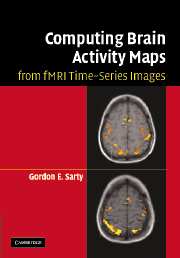1 - Introduction
Published online by Cambridge University Press: 07 December 2009
Summary
The production of a brain activity map from data acquired with a volunteer or patient and magnetic resonance imaging (MRI) requires a fairly wide range of interdisciplinary knowledge and techniques. Producing brain activity maps from functional MRI (fMRI) data requires knowledge and techniques from cognitive neuropsychology, physics, engineering and mathematics, particularly statistics. The process typically begins with a question in cognitive psychology that can be answered, at least in part, by combining the knowledge obtained from brain activity maps with previous knowledge of the function of specific regions of the brain. The previous knowledge of regional brain function generally has its origin in lesion studies where disease or injury has removed a brain region, and its function, from the brain's owner. Such lesion-based knowledge has firmly established the principle of functional segregation in the brain, where specific regions are responsible for specific functions. The use of fMRI to produce activation maps allows specific questions on functional segregation to be posed and investigated without risk to the person being studied. The brain is also known to be a very complex system in which several regions, working cooperatively, are required for some tasks. This cooperation among regions is known as functional integration and may be studied using fMRI techniques that lead to connectivity maps. Methods for producing activation and connectivity maps are reviewed here with the goal of providing a complete overview of all data processing currently available to produce the brain activity maps from raw fMRI data.
- Type
- Chapter
- Information
- Publisher: Cambridge University PressPrint publication year: 2006



